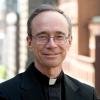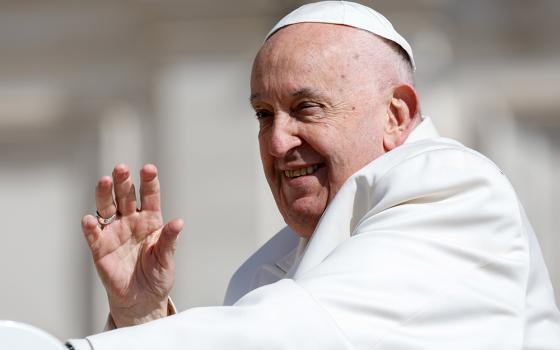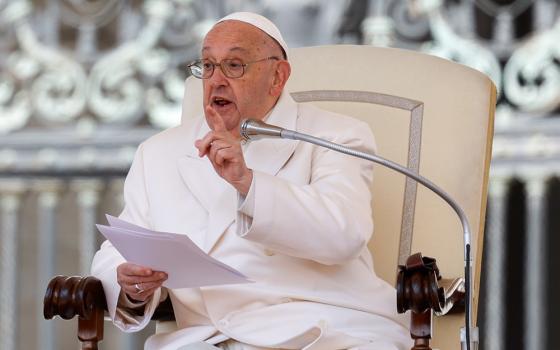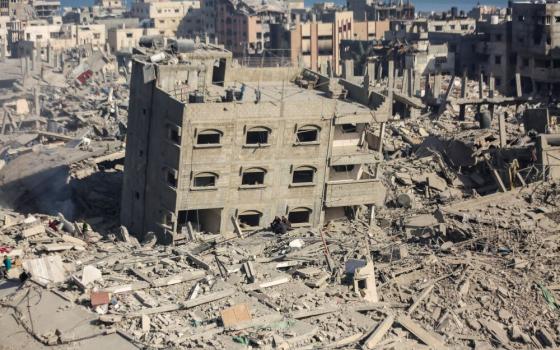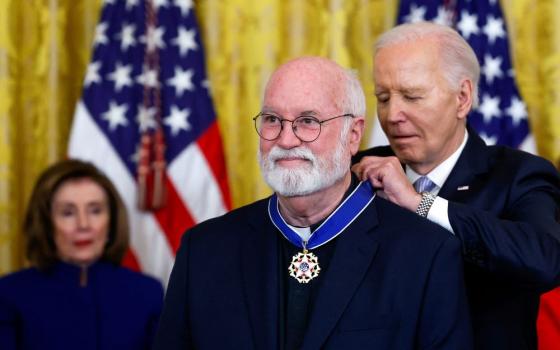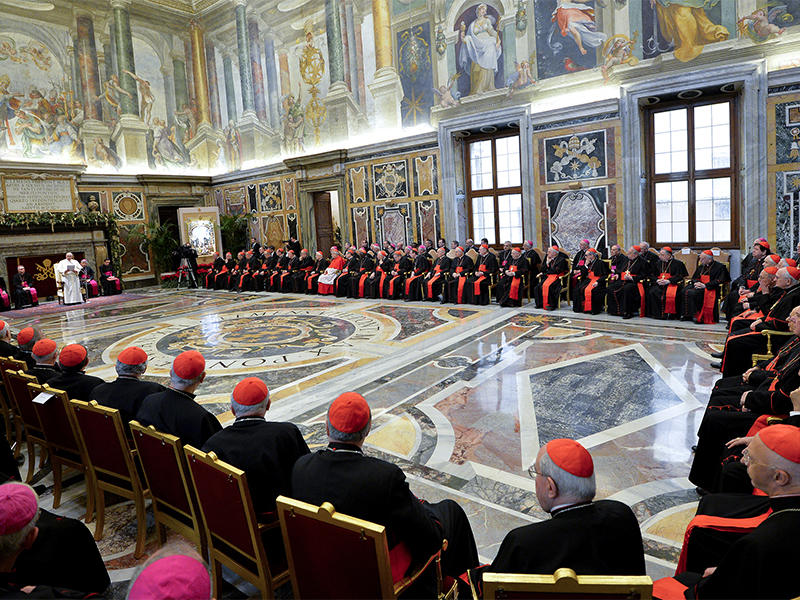
Pope Francis talks to the Roman Curia in the Sala Clementina at the Vatican on Dec. 22, 2014. (AP/Andreas Solaro, Pool)
The cardinals who voted in conclave to elect Pope Francis did so hoping he would reform the scandal-plagued Vatican Curia and make it more responsive to the concerns of the universal church. Six years later, his reform proposals are reportedly to be promulgated at the end of June, although they will probably be leaked earlier. Will they satisfy the critics of the Curia?
Reforming the Vatican Curia has been a constant topic since the Second Vatican Council ended in 1965. The Curia has been accused of being inefficient, Byzantine, dictatorial, and out of touch with the needs of ordinary Catholics. On top of that, it has been plagued by financial and sexual scandals.
Popes have rolled out reforms, but they have had little impact.
Paul VI did the most in the years following Vatican II, by requiring heads of Curia offices to submit their resignations at age 75 and by forcing bishops and cardinals off the congregations (the committees of cardinals and bishops that supervise the work of Vatican offices) when they reach 80.
He also created new offices, in response to the council's priorities, for dialogue with other Christian churches and with other religions. He created another office to focus on issues of justice and peace. Later popes added offices to deal with their pet projects.
But amid this innovation, the existing offices were not substantially changed. Conflict arose between the old offices and the new, as when those involved in ecumenical and interreligious dialogue were reprimanded by the Congregation for the Doctrine of the Faith and the Congregation for the Evangelization of Peoples.
Francis made some initial changes in the Curia when he became pope, merging some of the post-Vatican II offices so that fewer people report directly to him. He also combined the various media offices, but because of ineffectual leadership, the merger threw Vatican communications into chaos.
Perhaps his greatest impact has been on the culture of the Curia, rather than its structure. His constant emphasis on service and listening has changed how Curia officials interact with visiting bishops. In the past, 55 minutes of an hourlong meeting would be devoted to Curia officials lecturing the bishops. Now, more time is given to listening to the bishops' concerns.
The new reform proposals, however, are being presented as a comprehensive reform of church structures. Here are three questions to ask in evaluating these reforms:
First, does the reform convert the Vatican from a court to a civil service?
The Vatican is still organized as an 18th-century royal court where princes (cardinals) and nobles (bishops) help the king (pope) govern the nation (church). The problem with such a structure is that you can't fire princes and nobles when they prove incompetent. The church needs a competent civil service, not a court.
I have argued in the past that Curia officials should not be bishops or cardinals, which creates the impression that they are middle management between the bishops and the pope. Rather, they should be priests and laypersons, with expertise in their area of responsibility. As such, it would be clear they are not part of the magisterium. Rather, they are servants of the pope and the college of bishops. They are staff, not rulers.
Advertisement
Second, does the reform foster decentralization? What decisions currently made in the Vatican will now be made at the diocesan or episcopal conference level?
For example, more than two decades ago, the English-speaking conferences of bishops developed a very good translation of the liturgy, which was vetoed by Rome. The Vatican then forced the bishops to accept the terrible translation we have today. If the Vatican does not give up its stranglehold on this kind of decision-making, the new reforms will be meaningless. If every important decision must be reviewed by Rome, then things have not changed.
In the past, progressives have pushed for decentralization and conservatives have promoted papal power. Will this change now that progressives like the pope and conservatives question his policies? It will take another five years before enough of the old guard retire and the U.S. Conference of Catholic Bishops catches up with Pope Francis. In the meantime, do progressives want to give it more power?
Third, does the reform move the Vatican toward separating executive, legislative and judicial powers?
Because the Vatican is modeled on an absolute monarchy, there is no separation of powers. Today, Curia offices make the rules, police the rules and pass judgment on those who violate the rules.
A separation of powers would mean giving more authority to the synod of bishops, making it more like a real legislature. Perhaps the synod could have standing committees that would replace the committees of cardinals that make up Vatican congregations.
The Vatican also needs a separate department of justice to investigate and prosecute canonical crimes, whether they be sexual, financial or otherwise. The accused should be tried before an independent judiciary.
I expect, unfortunately, that the answers to all my questions will be "no." Although I love Francis, I expect to be disappointed by his reform proposals. Francis is a pastor, not a management expert. In addition, there are strong opponents of reform in the Curia. Some of the boxes on the organizational chart will be moved around, but it will make little difference.
Finally, all of us who propose reforms need to do so with humility. Social science and experience warn us that every reform has unanticipated consequences. That is why the church has tended to muddle through with incremental change rather than real revolution. On the other hand, incremental change will not deal with the issues facing the church today. More is needed.
[Jesuit Fr. Thomas Reese is a columnist for Religion News Service and author of Inside the Vatican: The Politics and Organization of the Catholic Church.]




